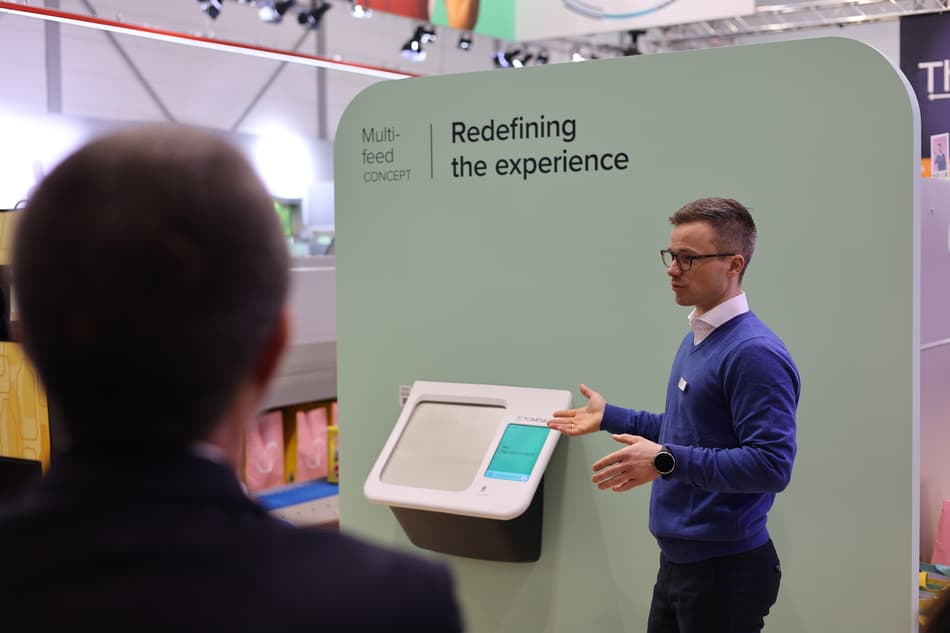Reducing the environmental footprint of TOMRA reverse vending machines
Christina Ek, Project Manager at TOMRA Collection, shares some insight into TOMRA's ongoing sustainability journey and efforts to minimize the environmental impact of TOMRA reverse vending machines. Christina addressed questions regarding actions being taken to enhance product sustainability, the possibility of achieving more with less, and the benefits these initiatives bring to TOMRA's customers.

TOMRA's positive impact and product responsibility
At TOMRA, we're extremely proud of our impact. Each and every year we capture more than 45 billion used beverage containers for recycling across more than 60 global markets. This is what is referred to in sustainability circles as our “handprint” – the positive impact created using our products. But there is another important side to this story, and that's our products' “footprint” – the negative environmental impacts created across their lifecycles.
TOMRA is a producer of equipment and machines, and we need to take responsibility for our products, not only during their production, but also during their use and at their end-of-life. How do we do that? At TOMRA, we start with design.
Sustainable product design and environmental considerations
Sustainable product design is about minimizing a product's environmental footprint. How a product is manufactured, how it's used, how long it lasts, and how it's disposed of, are all elements that must be considered when designing products and packaging. In fact, about 80% of the emissions associated with a product result from choices made during the design phase. That's why one of TOMRA's guiding principles for future product design revolves around sustainability.
On one hand, sustainable product design is about doing more with less – creating products that are literally made of less materials, yet at the same time made from better materials, and that consume less energy. A good example of how we have been approaching this challenge at TOMRA is the printer used for refund receipts in many reverse vending machines. Both TOMRA’s Single-Feed Concept and Multi-Feed Concept machines, which were presented at EuroShop earlier this year, come without the printer as standard, paving the way for a paperless, digital payout experience. No printer means saving materials from production, as well as less energy consumption while the machine is in use.
The Single-Feed Concept and the Multi-Feed Concept machines are also made with less material used in the front door, while maintaining the structural integrity of the machine. Using fewer materials saves emissions during production, but also means that the machine weighs less during transport, which further reduces emissions.
At the same time, sustainable product design is also about making resources last. We should create products and parts that last for as long as possible to fully utilize the value of the resources that are used. For example, with the new Multi-Feed Concept machine, our current customers have the opportunity to reuse their existing TOMRA T9 reverse vending machine and backroom equipment alongside it, maximizing the lifespan of the equipment that they already have.

Understanding the current footprint and driving retailer benefits through TOMRA's circular business ambition
We are proud to make products that are durable, effective, and that already incorporate a significant proportion of recyclable materials. While we're doing a lot to make our products more sustainable, we always strive to improve.
To further reduce the environmental impact of our products, it was important for us to understand TOMRA’s current footprint. We looked at a TOMRA T9 combined with three MultiPac backroom cabinets to understand where we should focus our efforts. The analysis showed that to be even better in the future, we should use a higher share of recycled materials, reuse electronic components wherever possible, and reduce power consumption.
To provide practical context to these measures, we can compare a representative reverse vending machine with other familiar products. For example, a standard freezer found in grocery stores consumes about 20,000 kilowatt hours per year. In contrast, a TOMRA T9 and MultiPac system consumes just 3,000 kilowatt hours per year, amounting to about 15% of the energy usage of a standard freezer.
Given the current surge in energy prices, retailers are facing increasing costs just running business as usual. Despite the fact that a TOMRA reverse vending system represents a small part of a retail store’s operations, our efforts to save energy consumption will ultimately benefit retailers and help them save costs.
However, there is another side to consider too. Retailers are facing increasing expectations from customers and regulators to set their own sustainability targets, and they have to report on the environmental emissions from goods and services that are obtained through suppliers – including TOMRA. So, when TOMRA reduces its environmental emissions, we indirectly help our customers achieve their sustainability targets. In this way, we are all connected.
TOMRA's integrated sustainability approach
TOMRA's ambition is to become a fully circular business. That means that we are committed to taking full responsibility for our products, reducing their impact and taking responsibility for all materials and machine parts along their value chains. While doing so, we will create as few emissions as possible – a concept that is known as net zero. This is very ambitious, and we have set high-reaching targets.
Among other goals, by 2030, TOMRA aims to ensure that:
- All new products incorporate at least 90% sustainable materials.
- At least 50% of our products will be circular at the end of their life cycles.
- Operational transport emissions are reduced by more than 80%.
To reach these targets, we have to bring sustainability into everything we do – and this is something we are already getting started with.
We are integrating sustainable product design into our core product development processes, for example, and TOMRA's business areas now report quarterly results, not only financially, but also in terms of Planet and People. We will continue to reduce the environmental impact of TOMRA products and take our commitment to our customers seriously when it comes to sustainability.
These efforts are all part of a much bigger movement at TOMRA and we look forward to sharing more about our sustainability transformation as it develops.
